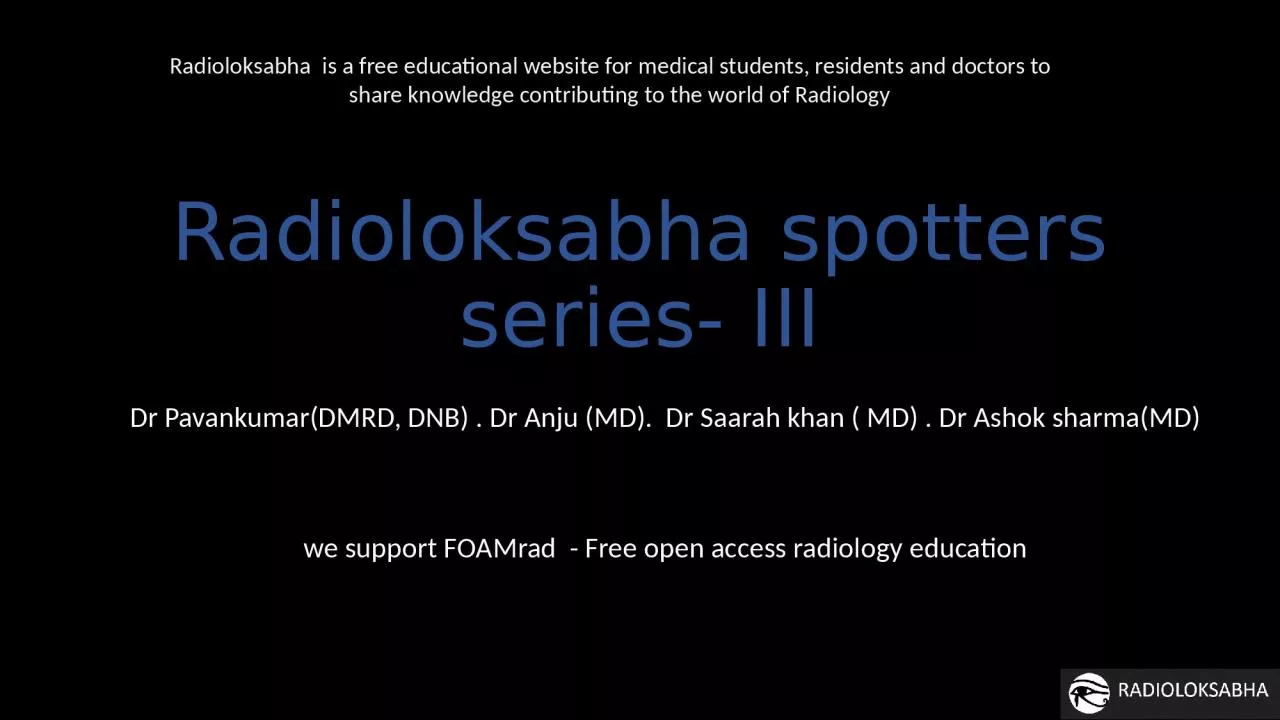

Saarah khan MD Dr Ashok sharma MD we support FOAMrad Free open access radiology education Radioloksabha spotters series III Radioloksabha is a free educational website for medical students residents and doctors to ID: 933827
Download Presentation The PPT/PDF document "Dr Pavankumar (DMRD, DNB) . Dr Anju (MD..." is the property of its rightful owner. Permission is granted to download and print the materials on this web site for personal, non-commercial use only, and to display it on your personal computer provided you do not modify the materials and that you retain all copyright notices contained in the materials. By downloading content from our website, you accept the terms of this agreement.
Slide1
Dr Pavankumar(DMRD, DNB) . Dr Anju (MD). Dr Saarah khan ( MD) . Dr Ashok sharma(MD)we support FOAMrad - Free open access radiology education
Radioloksabha
spottersseries- III
Radioloksabha
is a free educational website for medical students, residents and doctors to
share knowledge contributing to the world of Radiology
Slide2Slide3Slide4GIST- Gastrointestinal stromal tumorWell defined homogenously enhancing solid cystic lesion (precontrast HU:38, postcontrast HU:79) with non enhancing hypodense area (s/o necrosis) within approximately measuring x xmm (ApxTrXCc
) seen possibly arising jejunal loop with no obvious features of obstruction.The lesion is seen abutting left psoas muscle and left kidney. Craniocaudally the lesion is extending from level of L1 - L4 verebra.
Slide5Slide6Slide7Crohn’s disease with ankylosing spondylitis.There is evidence of circumferental hetrogenously enhancing(Pre contrast 31, Post contrast 60) short segment wall thickening of the terminal ileum (wall-thickness measuring 12mm) for a length of aprrox
. 4.5cm causing mild narrowing of the ileo-caecal junction. Extensive adjacent mesenteric fat stranding noted.Multiple enhancing enlarged lymph nodes noted in the mesentric region largest measuirng 12x10mm.
Slide8Slide9Slide10Slide11Ulcerative colitis* Circumferential enhancing wall thickening of sigmoid colon with significant adjacent paracolic fat stranding & minimal mucosal edema in the distal half of the rectum* Multiple enhancing pedunculated intraluminal lesions in the proximal rectum and in the sigmoid – suggestive of Polyps.
Slide12Slide13Slide14Slide15Crohn’s diseaseThere is significant thickening and luminal narrowing involving the cecum and ileocecal junction , wall thickening is also seen involving the adjacent terminal ileum.
Slide16Slide17Slide18Crohn’s diseaseWall thickening with mural stratification involving the small bowel.On sinogram ,well defined linear fistulous tract extending from the skin surface in the ischioanal fossa perianal region at 8O clock position in the transphincteric plane ,adjacent fat stranding and air pocket noted, communicating internally with rectum measuring for length of approx. 4 cm and maximum width of 6mm; contrast seen
opacifying the rectum, . No extravasation of contrast into the peritoneal cavity.
Slide19IC junction
Slide20Inflammatory bowel diseaseA long segment circumferential wall thickening, mural stratification and wall edema noted involving the ileum with maximum wall thickness of 13mm, causing mild luminal narrowing with adjacent fat stranding, with fibrofatty proliferation [creeping fat ] and positive vasa recta sign.Patulous IC junction.
Slide21Slide22Slide23Multiple basal collaterals bilaterally with occlusion of
supraclinoid ICA’s( Not shown)--Features suggestive of Moya moya disease- Suzuki stage III to IV.
Differentials Moyamoya syndrome etiologies:CNS vasculitis/ Autoimmune vasculitis.
Slide24Slide25Stenosis of
supraclinoid portion of both internal carotid arteries and bilateral anterior and middle cerebral arteries with multiple tortuous flow voids in lenticulostriate, thalamoperforating and dural arteries - s/o abnormal
moya moya collaterals giving puff of smoke appearance. Multiple linear FLAIR hyperintensities in the sulcal spaces of frontal, parietal and temporal lobes - s/o leptomeningeal collaterals. -- Features suggestive of grade III moya moya disease (Suzuki staging). Other close differential diagnosis to be considered are- slowly developing occlusive vasculopathies (sickle cell disease/NF1).
Slide26Slide27Left transverse and sigmoid sinus thrombosis
Slide28Slide29Slide30Evidence of a fairly well defined enhancing lesion noted in the floor of the mouth involving the right and left halves of tongue.The lesion is seen involving the superior longitudinal , transverse and genioglossus muscles of tongue.Multiple dilated tortuous flow voids noted within the lesion.The arterial supply is predominantly from the right lingual artery with few branches from the left lingual artery. Right facial and lingual veins are seen draining the lesion.
(Not shown)Features suggestive of arteriovenous malformation of tongue
Slide31Slide32Slide33Cerebral arteriovenous malformation
Slide34Slide35Slide36*Megalencephaly noted.*Evidence of bilateral symmetrical altered signal intensity noted throughout the deep and sub-cortical white matter of both the cerebral hemispheres, predominantly seen in the frontal, temporal and parietal lobes with relative sparing of cerebellar hemisphere and cortical grey matter. It appears hyperintense on T2/FLAIR, isointense on T1 sequences and restricts on DWI
*Evidence of multiple expansie bilateral symmetrical sub-cortical white matter cysts showing CSF signal intensity noted in the anterio-medial aspect of inferior temoral gyrus and lateral aspect of superior temporal gyrus, largest measuring 14x12mm noted in in the right temporal lobe.
Megalencephalic leucoencephalopathy [Van Der Knaap disease]
Slide37Slide38Slide39Slide40Multiple dilated and tortuous vessels located along the margins of the cerebellar hemisphere, brainstem , peripherally along the temporoparietal and occipital lobes, around the cavernous sinuses. These channels predominantly represent dilated and tortuous veins, bilateral transverse, left sigmoid sinus, internal cerberal veins, vein of galen and straight sinus are significantly dilated and tortuous.
Multiple arterial feeders are seen supplying these lesions wih involvement of feeders from bilateral middle cerebral, posterior cerebral , superior cerebellar and choroidal arteries
Dural AV fistula
Slide41Slide42Slide43Evidence of a fairly well defined T1/T2/FLAIR hyperintensity showing diffusion restriction in th left superior temporal gyrus, on contrast images showing enhancement of the lesion with - s/o herpes encephalitis with hemorrhage.
Herpes encephalitis
Slide44Slide45Slide46TB GranulomasMultiple well-defined enhancing lesions noted diffusely spread throughout, involving both the supra and infra-tentorial regions.
Slide47You can share presentation, cases, events and articles On Radioloksabha.com
Register at
https://www.radioloksabha.com/home.php
Download DNB/MD question papers, presentation and formats.
THANK YOU